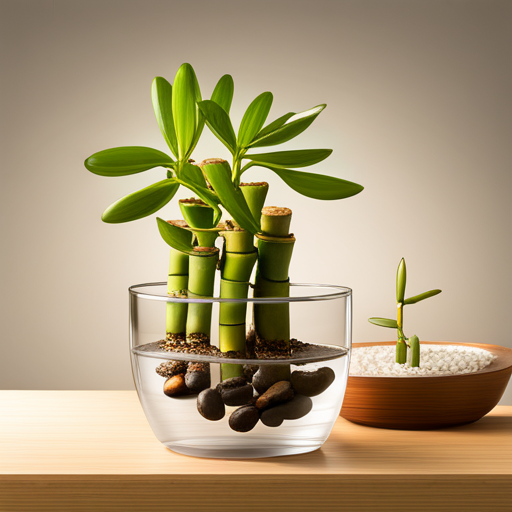Contents
- 1 How To Repot Lucky Bamboo In Rocks? Plant Bamboo Strategy
- 1.1 Our Highlighted Points
- 1.2 How to Care For Lucky Bamboo?
- 1.3 Growing Lucky Bamboo in Water
- 1.4 Tips for Lucky Bamboo Placement
- 1.5 Can I Use Similar Repotting Techniques for Desert Rose as I Would for Lucky Bamboo?
- 1.6 Frequently Asked Questions
- 1.6.1 Can lucky bamboo be repotted in rocks without water or soil?
- 1.6.2 What type of water should be used to fill the pot halfway when repotting lucky bamboo in rocks?
- 1.6.3 How often should the water level be checked when repotting lucky bamboo in rocks?
- 1.6.4 Is it necessary to change the water in the container weekly when growing lucky bamboo in rocks?
- 1.6.5 What are the different methods of propagating lucky bamboo, apart from rooting it in rocks or water?
How To Repot Lucky Bamboo In Rocks? Plant Bamboo Strategy
Lucky bamboo is a popular plant known for its versatility and ease of care. Repotting lucky bamboo in rocks is a common practice that requires attention and proper care. This article aims to provide a step-by-step guide on how to repot lucky bamboo in rocks, also known as the plant bamboo strategy.
The process begins with washing and drying the rocks, followed by preparing a new pot filled with rocks and non-chlorinated, non-fluoridated water. The lucky bamboo is then carefully removed from its old pot, checked for any yellow parts or damaged roots. It is then placed in the new pot, ensuring that the roots touch the bottom and rearranging the rocks for support.
The pot should be positioned in an area with ample sunlight but not direct sunlight. The water level should be monitored daily to keep the rocks covered, but the stalks should not be submerged. Additionally, the water in the container should be changed weekly.
Repotting lucky bamboo in rocks promotes its overall health and growth, making it a popular choice for home decor and gifting due to its association with good fortune and luck.
Our Highlighted Points
- Lucky bamboo can be repotted in rocks as a common practice.
- Wash the rocks with running water and let them dry before repotting.
- Use a new pot filled with rocks and halfway with non-chlorinated, non-fluoridated water.
– Ensure that the roots of the lucky bamboo touch the bottom of the new pot and rearrange the rocks for support.
How to Care For Lucky Bamboo?

Caring for lucky bamboo involves providing proper conditions such as adequate sunlight, non-chlorinated water, and regular monitoring of water levels, as stated in the pre-existing knowledge.
Lucky bamboo can be propagated by taking cuttings and placing them in water until roots emerge, then transferring them to pebbles or soil. This method is simple and effective for growing new lucky bamboo plants.
Additionally, lucky bamboo has various benefits in home decor, as it is believed to bring good luck and fortune. Its green leaves and straight stems make it an attractive and versatile houseplant.
Lucky bamboo can be placed in a fish tank for a unique touch or arranged in different formations to add visual interest to any space.
Overall, proper care and attention are essential for maintaining the overall health and growth of lucky bamboo.
Growing Lucky Bamboo in Water

Growing lucky bamboo in water is a commonly preferred method due to its simplicity and effectiveness.
Propagating lucky bamboo in water offers several benefits. Firstly, it eliminates the need for soil, making it a cleaner and less messy option. Additionally, growing lucky bamboo in water allows for better visibility of the roots, making it easier to monitor their health and growth. This method also provides a constant water supply, ensuring that the plant receives the necessary hydration. Moreover, growing lucky bamboo in water can prevent issues such as overwatering or underwatering, as the plant will naturally take up the water it needs.
Overall, this method of propagation is convenient and reliable, making it a popular choice among lucky bamboo enthusiasts.
Tips for Lucky Bamboo Placement

Placement of lucky bamboo is crucial for its optimal growth and aesthetic appeal. When considering the placement of lucky bamboo, one must take into account the different types of pots available. Lucky bamboo can be placed in various containers such as glass vases, ceramic pots, or even decorative containers. The choice of pot depends on personal preference and the desired look.
In addition to the type of pot, Feng Shui principles can also guide the arrangement of lucky bamboo. According to Feng Shui, lucky bamboo should be placed in the east or southeast direction of a room. This is believed to attract positive energy and good fortune.
It is also important to avoid placing lucky bamboo in areas with excessive heat or direct sunlight, as this can lead to leaf burning and damage.
By considering the type of pot and incorporating Feng Shui principles, one can create a harmonious and visually pleasing arrangement of lucky bamboo.
Can I Use Similar Repotting Techniques for Desert Rose as I Would for Lucky Bamboo?
Yes, you cannot use similar repotting techniques for Desert Rose as you would for Lucky Bamboo. To propagate Desert Rose, you need to follow specific steps that cater to the plant’s unique needs. Research and understand the exact “how to propagate desert rose” to ensure successful growth and development.
Frequently Asked Questions
Can lucky bamboo be repotted in rocks without water or soil?
Lucky bamboo can be repotted in rocks without water or soil. Repotting bamboo in rocks without water involves placing the bamboo directly into a pot filled with rocks. Repotting bamboo in rocks with soil requires adding soil to the pot along with the rocks.
What type of water should be used to fill the pot halfway when repotting lucky bamboo in rocks?
Bamboo can get burned under excess heat. When repotting lucky bamboo in rocks, it is recommended to use filtered water. This helps prevent leaf burning and ensures the plant’s overall health. Different types of rocks, such as pebbles or river rocks, can be used for repotting lucky bamboo.
How often should the water level be checked when repotting lucky bamboo in rocks?
The water level should be checked daily when repotting lucky bamboo in rocks. This is important to ensure that the rocks are covered with water but the stalks are not submerged, meeting the watering requirements of the plant.
Is it necessary to change the water in the container weekly when growing lucky bamboo in rocks?
Changing water in the container weekly is necessary when growing lucky bamboo in rocks. However, propagating lucky bamboo in rocks allows for an alternative method of growth without the need for water.
What are the different methods of propagating lucky bamboo, apart from rooting it in rocks or water?
Different methods of propagating lucky bamboo, apart from rooting it in rocks or water, include using potting mixtures. These mixtures provide the necessary nutrients and support for the bamboo to grow and develop roots.

